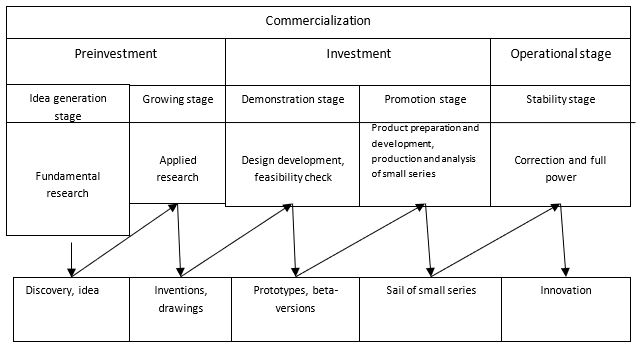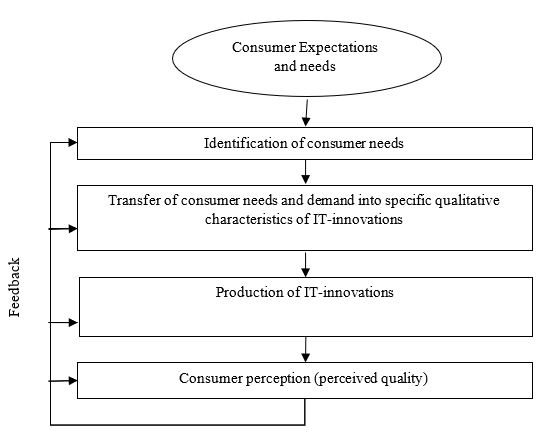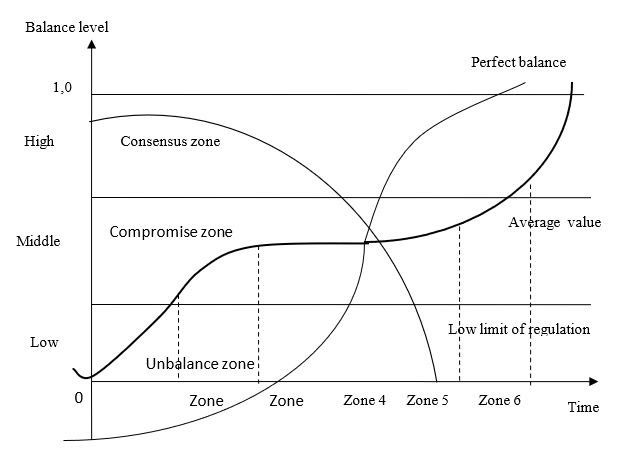Management System Concept For Commercialization Of Intellectual Property Objects Regarding Interest Alignment
Abstract
Management of commercialization of intellectual property objects (IPO) is implemented through general management functions, namely planning, organization and motivation of management entities to develop and implement innovative ideas, control and regulate the process of execution of innovative development plans. The paper analyzes main approaches to innovation commercialization. Stages of commercialization were studied, based on which a conceptual scheme was built, considering the theory of management of the innovation system, principles, to which the commercialization management system should correspond. They can be divided into general and special groups. General principles relate to all business processes. Special principles are necessary in implementation of commercialization; take into account general management functions, factors of external and internal environment, balance level that must be in the zone of compromise or consensus. The concept basis is formed by principles with which the commercialization management system must comply. Considering external and internal factors in the management of the IPO commercialization, strategic, design, system, marketing, and functional approaches are applied. For the innovation management system, for many other open and complex economic systems, the presence of goals, functions and methods of management is typical. There is a clear idea of what needs to be done and in what ways; a combination of social, technical, economic and informational components; presence of connections between elements in the system; etc. In accordance with this idea, a conceptual system was created to manage commercialization of IPO in terms of the agreement between interests of the producer and the consumer.
Keywords: Intellectualpropertymanagementconceptcommercialization
Introduction
To manage the commercialization of IPO effectively, it is necessary to establish the nature of the interactions (communication) between the participants in the innovation development process, determine the order of information exchange and the sequence of application of the appropriate tools.
Problem Statement
For the purpose of operational management of IPO and their commercialization, it is necessary to map out at the conceptual level the functional interrelations of managing the commercialization of IPO in terms of interest alignment of the producer and the consumer.
Research Questions
The subject of the research is the conditions and patterns that ensure the management effectiveness of IPO.
Purpose of the Study
The aim of the study is to develop the management concept of commercialization of IPO (in terms of interest alignment of the state, producers and consumers)
Research Methods
In the research process, system, analytical, and mathematical methods were used, which in their interaction, constitute the method of the integrated system structural and functional analysis..
Findings
Each form or method of commercialization of innovative products fit the enterprise to a greater or lesser extent. It depends on its goals and capabilities. However, to determine the financial capabilities of an enterprise regarding the selection of potential forms and methods of commercializing innovative products, it is necessary to identify all the costs necessary to implement this process. Indeed, in the case of incorrect calculations, it is possible to lose all financial resources allocated for commercialization of innovations. It should be noted that the costs, according to the forms and methods, can be divided into general and additional. Generals are those that are non-negative for any forms and methods, and additional ones are those that are directly inherent in certain forms and methods.
Professor Matkovskaya, (2010) identifies sixteen stages of commercialization process of innovative technologies: basic research; applied research; selection of ideas and development of the concept of innovative technology; business plan preparation for investors; search for investors; implementation of design and exploration work; creation of an industrial design; patenting; introduction of innovative technology to the market; the transfer of innovative technology (in cases where innovation is bought by an innovative consumer organization); a business plan for the introduction of innovative technology; implementation: consulting, installation, adaptation; exploitation of innovative technology; service and service; improvement of innovative technology; modification of the innovation technology (Figure

The concept basis is formed by the principles to which the commercialization management system must conform (Kvashnin, 2006). Therefore, on the basis of the analysis, we distinguish two groups: general economic group and specific group (table
The conceptual value of commercialization and the relevance of the formation of a modern theory of innovation commercialization is provided at the levels of the economic system. It was established that at the macro level, commercialization is a part of the national innovation system and a condition for ensuring economic development. At the micro level, commercialization is a tool to introduce the results of innovation activity and obtain a commercial effect and successively change the stages of innovation and also the final stage of the development process of a new product (Utkin, & Morozova, 1996).
The model of interaction between manufacturers of innovative products and consumers can be represented in the form of various schemes. The first scheme assumes a simple purchase – sale relationship, the second one determines the relationship when the conditions for the completion of the novation are specified (the seller helps to master the novation and provides paid services). The third scheme defines the relations aimed at participation with its developments and scientific capabilities in integrated formations through the creation of joint ventures, associations, and innovative technopark structures. The basis of the competitive success of a manager-innovator is its ability to identify actual or potential needs and demands of consumers in relation to innovations and satisfy them more effectively than competitors in a manner.
An important factor for the enterprise success in the market it occupies is the ability to evaluate and establish a favorable balance of interests of all actors acting in the area of interests of the enterprise, for example, a compromise between the consumer and the manufacturer.
Formation of the sale price by the manufacturer consists in establishing the optimal ratio of the demand for its products and the ability of the enterprise to offer the necessary volumes of products. The art of compromise in the process of pricing conducted by the manufacturer is to achieve the maximum profit during the entire period of production by varying the price in such a way as to keep the consumer from going to the competitor, or switch the buyer's interest to a substitute product.
Consequently, the benefits of achieving long-term and sustainable cooperation by achieving a price compromise between the producer and the consumer become apparent.
The company in the process of its sustainable development is constantly influenced by internal factors and external factors of the functioning of stakeholders of the enterprise. The positive and negative influence of external and internal factors on the indicators of interests of the producer and the consumer should be taken into account.
Depending on the external and internal factors, the enterprise development, according to the indicators of the producer and the consumer interests, may include various elements, operational subsystems and methods: identification of imbalance factors; expert evaluation of factors of the level of imbalance characteristics and others. Development management according to indicators of interests of the producer and the consumer is a set of resources, methods and control functions interacting with direct and feedback connections.
Figure

The efficiency of use is expressed in the reduction of economic losses and risks from delay in responding to changes in environmental factors and development goals. The main result of reducing the imbalance with methods for improving the quality of managing the development of an enterprise is to expect its steady state as an integrated system.
The main problem of this study is the lack of necessary tools for quantitative and qualitative assessment of quality regulation imbalance and interest management efficiency of the producer and the consumer. The following estimates were taken as quantitative results in fractions of units on the E. Harington scale (Alabugin, 2014):
consensus - a high level of balance in the characteristics of an enterprise (achieved with high indices of quality of management development in terms of imbalance quality index (0.8 - 1.0));
compromise - the average level of balance of characteristics (in this study it is proposed to take the standard imbalance quality index (0.39 - 0.8));
imbalance - a low level of balance or a complete lack of a balance of target characteristics (usually characteristic of uncontrolled development processes of the enterprise imbalance quality index (0.01 - 0.39)).
The paper uses the ratio of the concepts of “imbalance level” (IL) and “balance level” (BL): BL = 1 - BL.
With their effective use, a balance of interests is ensured in the long run. Balance is an obligatory condition for sustainable development. The assessing criterion the acceptable management quality is the position of balance level in the zone of compromise (as a standard) or consensus.
Figure

With a high degree of negative impact of factors on the balance and poor management quality there is “imbalance”; “compromise” is possible with a moderate degree of influence, and with a low influence degree “consensus” of intergroup interests of the enterprise and interested parties can occur. Thus, the level of imbalance varies in the range of “consensus - compromise - imbalance” depending on the degree of identified influence (Forester, 1974; Forester, 2003; Meadows, Meadows, & Randers, 1994; Meadows, Meadows, Randers, & Behrens, 1991).
The first stage of the life cycle of imbalance (zone 1) is determined by mechanism imbalances for management of enterprise development. A slight increase in balance level is determined by the unintended coordination of stakeholders and interests of the enterprise.
It is clear that indicators-factors at the second stage of the cycle in zone 2 and 3 when crossing a compromise zone increases from low to medium level of balance. Their rise is supported by the construction and application of special functions in the created mechanism and the enterprise management system.
The indicators at the third stage of the cycle are in a stabilized position (zone 4). For a set of enterprise management elements, similar properties of target characteristics of an enterprise and stakeholders that are in a compromise zone or a “compromise-consensus” border zone are more convenient according to the criterion of the enterprise’s sustainable development.
Cycle indicators in zone 5 at the fourth stage are formed, just as the management functions are productively performed. For this reason, appropriate transformation alternatives such as stability (1), rise (2), or decline (3). It is required to continuously monitor the dynamics of imbalance life cycle indicators to redesign the mechanism, structural development of the management system.
To eliminate the conflict, a negotiation process is used, which consists of the following stages: a) an analysis of needs (own and opposite); b) the choice of a negotiating style; c) climate control of negotiations; d) determination of negotiation tactics; e) management of negotiations development; f) results evaluation and consequences of the negotiations (Burkov, & Novikov, 1999).
The magnitude of the negative impact is determined by the size of the losses due to imbalance of interests. For example, there is imbalance of an enterprise and an interested party “consumer” associated with the product being produced and consumed. Enterprise management saves resources on product quality assurance. Consumers, in turn, are not satisfied with the quality of the product - this is contrary to their interests. If enterprise management does not take timely and appropriate measures to resolve the conflict that has arisen, the imbalance degree will increase from low to high. With a high degree of imbalance, the company begins to lose its customers, which, in turn, can lead to disastrous consequences, in particular, to the enterprise bankruptcy.
The types of imbalance by the occurrence nature should be divided into spontaneous and expected (regulated and planned). If there is a mechanism for enterprise management formation on imbalance basis, then the managers plan the imbalance occurrence and carry out the appropriate management decisions. When an enterprise does not have such a mechanism, there is a high probability that the processes will be spontaneous in this situation. Imbalance can remain at an optimal level for both parties, if the company's supply department interacts on a mutually beneficial basis with the “supplier” interested party and the economic situation in the region is stable. In this situation, there is no particular need for intentional intervention. However, if the prices for raw materials suddenly increased, an unplanned or uncontrolled imbalance appears (Alabugin & Shageev, 2014).
In most cases, the balance state is determined by the quantitative ratio, which consist of two parts, and should be equivalent to each other, in particular, reflect the receipt and expenditure of an equal amount of resources or results. Consequently, the balance of interests requires understanding how the regulated result of the interaction of interests (in the goal assessment) of the enterprise’s product producer’s complex and its consumer, at the same time investment in commercialization becomes cost-effective for each of the parties (Shageev, 2015).
In scientific literature there is no permissible formulation of interest imbalance in the commercialization process. As a result, it is recommended to expand this concept in the following interpretation - the unacceptable degree of their differences at the manufacturer and the interested parties-consumers of products from the level of their balance, or an agreement in the area of interest compromise.
Conclusion
The commercialization management of intellectual property objects is implemented through general management functions, namely planning, organization and motivation of management entities to develop and implement innovative ideas, control and regulate the process of execution of constructed plans for innovative development.
From the position of a system approach, the management system for innovation commercialization is an open system, which is formed under the influence of factors of the external and internal environment, and includes elements that ensure the goal achievement (Novikov, & Ivashchenko, 2006).
The external environment (consumers, suppliers, intermediaries, competitors, investors, the legislation, the level of equipment and technology) has an impact on the management object, that is innovation activity and all processes associated with it, and determines the parameters of the system input and output.
For system innovation management, as well as for many other open and complex economic systems, it is typical to have goals, functions and management methods, that is, a clear idea of what needs to be done and in what ways; a combination of social (people), technical (machines, mechanisms, equipment), economic (limited resources) and information (information flows and decision-making) components; the presence of connections between elements in the system (circulation of material and information flows); the presence of connections between the system and elements of the external environment.
Balance is considered an obligatory condition for the sustainable development. The balance level should be in a zone of compromise or consensus. In case the indicators are not within the established limits, the parties try to find ways to increase of commercialization management to achieve an acceptable result.
References
- Alabugin, A. A., Shageev D. A. (2014). Development management of an industrial enterprise in terms of imbalance of intergroup and organizational interests: theory and practice: monograph. Chelyabinsk: Publishing house NOUVPO RBIU, 236.
- Bureeva, N. N. (2007). Multivariate statistical analysis using the “STATISTICA”. Nizhny Novgorod.
- Burkov, V. N., Novikov D. A. (1999). Theory of Active Systems: State and Prospects. Moscow: Sinteg.
- Deryabina, I. Yu. (2017). The concept of commercialization management System of intellectual property objects. Retrieved from: http://www.vestnik.vsu.ru/pdf/econ/2017/04/2017-04-02.pdf.
- Forester, D. (1974). Dynamics of development of the city. Moscow: Progress.
- Forester, D. (2003). World Dynamics. Moscow: Publishing house AST; St. Petersburg: Terra Fantastica. Retrieved from: http://studbooks.net/1118511/pravo/upravlenie.
- Katalevsky, D. Yu. (2015). Fundamentals of simulation and system analysis in management. Moscow: Delo Publishing House, RANEPA.
- Kvashnin, A. (2006). How to manage a portfolio of technologies and intellectual property. EuropeAid project "Science and commercialization of technologies", 7.
- Matkovskaya, Ya. S. (2010). Commercialization marketing of market innovations: theory and methodology: dissertation author's abstract for the degree of Doctor of Economic Sciences. Rostov-on-Don.
- Meadows, D. H., Meadows, D. L., Randers, I. (1994). Beyond the growth. Moscow: Pangea.
- Meadows, D. H., Meadows, D. L., Randers, I., Behrens, V. V. (1991). Limits to Growth: A Report for the Club of Rome's Project on the Predicament of Mankind. Moscow: Moscow University Press.
- Novikov, D. A., Ivashchenko, A. A. (2006) Models and methods of organizational management of company innovative development. Moscow: KomKniga.
- Salimova, T. A. (2008). Quality management: textbook in the specialty "Organization Management". Moscow: Omega-L Publishing House.
- Sidorenko, V. N. (2001). System-dynamic modeling in POWERSIM environment: Reference interface and functions. Moscow: MAX-PRESS.
- Shageev, D. A. (2015). Development Management of industrial enterprises by imbalance indicators of target characteristics: (Dissertation for candidate of Economic Sciences). Chelyabinsk.
- Utkin, E. A., Morozova, N. I. (1996). Innovation Management. Moscow: AKALIS.
Copyright information

This work is licensed under a Creative Commons Attribution-NonCommercial-NoDerivatives 4.0 International License.
About this article
Publication Date
29 March 2019
Article Doi
eBook ISBN
978-1-80296-057-0
Publisher
Future Academy
Volume
58
Print ISBN (optional)
-
Edition Number
1st Edition
Pages
1-2787
Subjects
Sociolinguistics, linguistics, semantics, discourse analysis, science, technology, society
Cite this article as:
Tsybulskaia, L., Ryabtseva, Е. Е., Strashko, Е. V., Zelinskaya, Е. L., & Elistratova, А. I. (2019). Management System Concept For Commercialization Of Intellectual Property Objects Regarding Interest Alignment. In D. K. Bataev (Ed.), Social and Cultural Transformations in the Context of Modern Globalism, vol 58. European Proceedings of Social and Behavioural Sciences (pp. 1211-1219). Future Academy. https://doi.org/10.15405/epsbs.2019.03.02.140
